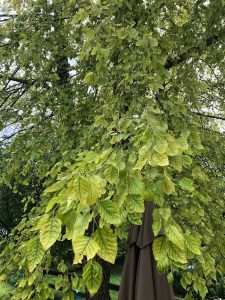Micronutrients
Megan Blauwet
- Identify functions of micronutrients in the plant
- Match soil properties with potential deficiencies
Micronutrients make up a small percentage of the overall plant, but are critical for growth. Most are used in enzymes rather than structural components of the plant.
Extreme cases, like extreme pH values, peat soils, or otherwise unusual conditions makes deficiencies more likely. Since deficiencies are resolved by small quantities per area, they may be added to other mixes or strategy that allows more effective spreading. Materials such as manure or composts may be used, depending upon analysis.
There are eight micronutrients that are essential for plant growth. These include boron, zinc, manganese, molybdenum, iron, copper, chlorine, and nickel. All micronutrients are needed in small amounts so when soils contain too much of them, toxicity can occur.
Boron (B)
Boron is used in plants for germination, pollination, sugar transport, cell wall development, protein formation, and carbohydrate metabolism. Boron is one of the most common micronutrient deficiencies. Boron is most often limited in alkaline soils and oppositely can have toxic amounts in acidic soils. A deficiency in boron will affect the vegetative and reproductive growth of the plant. Deficiency symptoms include chlorosis, death of buds/flowers, and death of new growth. A fertilizer most often used to add boron to the soil is sodium borate which contains around 10-20% boron.
Zinc (Zn)
Zinc is a part of many enzymes in the plant that are used for metabolic functions. A lack of zinc will create problems with protein, carbohydrate, and chlorophyll formation. Deficiencies are most likely to occur in calcareous soils with low organic matter and high pH. Zinc has a relationship with phosphorus in the soil where too much phosphorus can result in Zn deficiency. Deficiency symptoms include striping of corn leaves or yellowing of leaves. Zinc sulfate is the most common fertilizer used to add Zn to soils.
Manganese (Mn)
Manganese is an important micronutrient involved in critical functions in the plant such as photosynthesis, nitrogen assimilation, and respiration. Deficiency is most likely to occur in high pH soils and toxicity can occur in low pH soils. Manganese competes with iron in the soil so it is important to keep them balanced. The symptoms of Mn deficiency includes yellowing of leaves with wide green areas on the veins. Manganese sulfate is a common fertilizer added to soils that are deficient.
Molybdenum (Mo)
Molybdenum is a part of enzymes that are used in nitrogen fixation, nitrate reductase (converting nitrate into proteins), and the conversion of inorganic phosphate to organic. Unlike most other micronutrients, molybdenum deficiencies occur in acidic soils. Toxic amounts of molybdenum in plants used to feed animals can be quite harmful. Since molybdenum is related to nitrogen functions in plants, deficiencies can look similar and result in yellowing of leaves and stunting of growth. Fertilizers that add molybdenum include sodium molybdate and ammonium molybdate.
Iron (Fe)

Iron is a part of many enzymes and is used for chlorophyll formation, cell division and growth, and oxygen transport. Iron deficiencies are found in soils with high clay content or high pH soils. Interveinal chlorosis is the most typical iron deficiency symptom. Iron added to the soil in fertilizers is often chelated iron which will be available for longer in the soil. A foliar spray of ferrous sulfate is also available and commonly used.
Copper (Cu)
Copper is a part of enzymes critical for photosynthesis, respiration, and lignin production. Copper deficiencies are not very common in most soils but can be found in sandy soils or peat soils with very high organic matter. Plant deficiency symptoms include slight yellowing of leaves and leaf tip twisting or death. Copper sulfate is a common fertilizer applied to fix copper deficient soils.
Chlorine (Cl)
Chlorine is used in stomata regulation, osmotic regulation, and disease resistance. Chlorine can be problematic in arid regions due to it largely being found in salt forms in soil. Chlorotic or necrotic spots on leaves and wilting are common deficiency symptoms. Potash (KCl) fertilizer is often applied for its potassium, but it also provides chloride to the soil.
Nickel (Ni)
Nickel is the most recently discovered plant micronutrient. Its function in the plant is as a cofactor for the conversion of urea into a plant available form. Nickel deficiency in plants is very rare but can appear as necrosis of leaves (due to buildup of urea) and is most likely to be found in high pH soils. If a soil is low on nickel, nickel sulfate fertilizer can be added.

Type your key takeaways here.
- Micronutrients are essential to plants but needed in small amounts.
- There are 8 essential plant micronutrients and most are a part of enzymes or used in metabolic functions.

